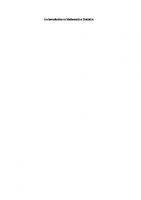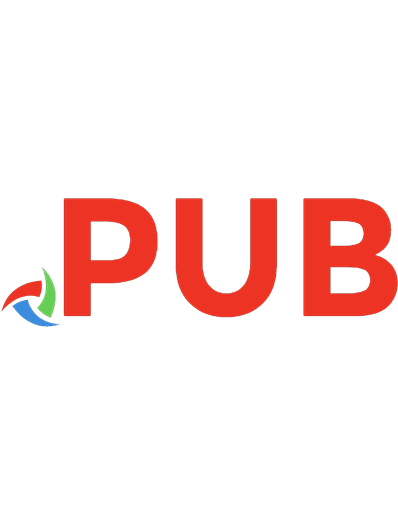An Introduction to Mathematical Reasoning: numbers, sets and functions 9780521597180, 0521592690, 0521597188, 9780521592697
3,374 389 13MB
English Pages [364] Year 2010
Polecaj historie
Table of contents :
Preface
1
2
3
4
5
6
7
8
9
10
11
12
13
14
15
16
17
18
Part I: Mathematical statements and proofs
The language of mathematics
Implications
Proofs
Proof by contradiction
The induction principle
Problems I
Part II: Sets and functions
The language of set theory
Quantifiers
Functions
Injections, surjections and bijections
Problems II
Part III: Numbers and counting
Counting
Properties of finite sets
Counting functions and subsets
Number systems
Counting infinite sets
Problems III
Part IV: Arithmetic
The division theorem
The Euclidean algorithm
Consequences of the Euclidean algorithm
Linear diophantine equations
Problems IV
page ix
1
3
10
21
30
39
53
59
61
74
89
101
115
121
123
133
144
157
170
182
189
191
199
207
216
225
Part V: Modular arithmetic
19 Congruence of integers
20 Linear congruences
21 Congruence classes and the arithmetic of remainders
22 Partitions and equivalence relations
Problems V
Part VI: Prime numbers
23 The sequence of prime numbers
24 Congruence modulo a prime
Problems VI
Solutions to exercises
Bibliography
List of symbols
Index
229
231
240
250
262
271
275
277
289
295
299
345
346
347
Citation preview
An Introduction to Mathematical Reasoning
An Introduction to Mathematical Reasoning numbers, sets and functions Peter J. Eccles Department of Mathematics University of Manchester
CAMBRIDGE UNIVERSITY PRESS
CAMBRIDGE UNIVERSITY PRESS Cambridge, New York, Melbourne, Madrid, Cape Town, Singapore, Sa~o Paulo, Delhi, Dubai, Tokyo Cambridge University Press The Edinburgh Building, Cambridge, CB2 8RU, UK Published in the United States of America by Cambridge University Press, New York www.cambridge. org Information on this title: www.cambridge.org/9780521597180 © Cambridge University Press 2007 This publication is in copyright. Subject to statutory exception and to the provisions of relevant collective licensing agreements, no reproduction of any part may take place without the written permission of Cambridge University Press. First published 1997 Thirteenth printing 2010 Printed in the United Kingdom at the University Press, Cambridge A catalogue record of this publication is available from the British Library Library of Congress Cataloging in Publication data Eccles, Peter J., 1945An introduction to mathematical reasoning: lectures on numbers, sets, and functions / Peter J. Eccles. p. cm. Includes bibliographical references and index. ISBN 0 521 59269 0 hardback- - ISBN 0 521 59718 8 paperback 1IT .elti. Prooftheory. I. Title. QA9.54.E23 1997 511.3-dc21 97-11977 CIP ISBN 978-0-521-59269-7 hardback ISBN 978-0-521-59718-0 paperback
Cambridge University Press has no responsibility for the persistence or accuracy of URLs for external or third-party internet websites referred to in this publication, and does not guarantee that any content on such websites is, or will remain, accurate or appropriate. Information regarding prices, travel timetables and other factual information given in this work are correct at the time of first printing but Cambridge Universtiy Press does not guarantee the accuracy of such information thereafter.
I too will something make And joy in the making; Altho' tomorrow it seem Like the empty words of a dream Remembered on waking. Robert Bridges, Shorter poems.
In loving memory of Elizabeth Baron and John Baron (Auntie Lizzie and Uncle Jack) and those Woodside Bank summers
Contents
Preface 1 2 3 4 5
6 7 8 9
10 11 12 13 14
15 16 17 18
Part I: Mathematical statements and proofs The language of mathematics Implications Proofs Proof by contradiction The induction principle Problems I Part II: Sets and functions The language of set theory Quantifiers Functions Injections, surjections and bijections Problems II Part III: Numbers and counting Counting Properties of finite sets Counting functions and subsets Number systems Counting infinite sets Problems III Part IV: Arithmetic The division theorem The Euclidean algorithm Consequences of the Euclidean algorithm Linear diophantine equations Problems IV Vll
page ix 1 3 10 21 30 39 53 59 61 74 89 101 115 121 123 133 144 157 170 182 189 191 199 207 216 225
viii
Contents
Part V: Modular arithmetic Congruence of integers Linear congruences Congruence classes and the arithmetic of remainders Partitions and equivalence relations Problems V Part VI: Prime numbers 23 The sequence of prime numbers 24 Congruence modulo a prime Problems VI Solutions to exercises Bibliography List of symbols Index
19 20 21 22
229 231 240 250 262 271 275 277 289 295 299 345 346 347
Preface
This book is based on lectures given at the Victoria University of Manchester to first year Honours Mathematics students including those taking joint or combined degrees. In common with most other British mathematics departments, the Manchester mathematics department has thoroughly reviewed its curriculum in recent years in the attempt to meet more adequately the needs of students who have experienced the effects of the great changes in the teaching of mathematics in schools, as well as the increased numbers of 'mature students' and students from non-standard backgrounds. It was clear to us at the University of Manchester that we should completely rethink and broaden our curriculum, including material which we had previously expected students to know on entry to the course but also including introductory material on combinatorics, computer skills and numerical mathematics, as well as encouraging the development of problem solving skills. A key ingredient of this new University of Manchester curriculum is a module on Mathematical Reasoning whose purpose is to introduce the basic ideas of mathematical proof and to develop skills in writing mathematics, helping to bridge the gap between school and university mathematics. This book is based on this course module. The ability to write correct and clear mathematics is a skill which has to be acquired by observing experienced practitioners at work in lectures and tutorials, by learning to appreciate the details of mathematical exposition in books, and by a great deal of practice. It is a skill readily transferable to many other areas and its acquisition is likely to be one of the main benefits of a mathematics degree course for most students who may well make no further use of most of the specific mathematical content of the course! There is no absolutely correct way of writing out a given proof. For IX
x
Preface
example, it is necessary to take into account who the intended reader is. But, whoever the reader is, the proof should be expressed as clearly as possible and to achieve this the writer needs to understand the logic of the proof. Writing a proof is not separate from discovering the proof in the way that writing up a scientific experiment is separate from carrying out the experiment or performing a piece of music is separate from composing it. Attempts to write out a proof are an important part of the discovery process. Alison Leonard has written in a totally different context: Not only are human ideas conveyed by language, they are actually formed by the language available to us.f So it is in mathematics, where we find a parallel development of mathematical ideas and mathematical language. This is reflected in this book. The emphasis is on helping the reader to understand and construct proofs and to learn to write clear and concise mathematics. This can only be achieved by exploring some particular mathematical topics and the contexts chosen are set theory, combinatorics and number theory. These topics • provide good examples to illustrate a range of basic methods of proof, in particular proof by induction and proof by contradiction, • include some fundamental ideas which are part of the standard tool kit of any mathematician, such as functions and inverses, the binomial theorem, the Euclidean algorithm, the pigeonhole principle, the fundamental theorem of arithmetic, and congruence, • build on ideas met in early schooling illustrating ways in which familiar ideas can be formulated rigorously, for example counting or the greatest common divisor, • include some of the all time great classic proofs, for example the Euclidean proofs of the irrationality of root 2 and the infinity of primes, but also ideas from throughout mathematical history so that there is an opportunity to present mathematics as a continually developing subject. Roughly speaking, the first three parts of the book are about the basic language of mathematics and the final three parts are about number theory, illustrating how the ideas of the earlier parts are applied to some significant mathematics. The reader may find that the later parts t See Alison Leonard, Telling our stories: wrestling with a fresh language for the spiritual journey, Dorton, Longman and Todd, 1995.
Preface
xi
contain some more straightforward material than the early parts simply because there is material on problem solving techniques which can then be practised on specific numerical examples. The topics selected for these later parts, the Euclidean algorithm, modular arithmetic and prime numbers, include material from the whole of mathematical history from classical Greek times to the present day. I would encourage the reader in working through the first three parts not to expect to understand everything at first. Part I introduces various forms of mathematical statements and the standard methods of proof. Proof by contradiction and proof by induction are explained in detail and these methods are then used again and again throughout the remainder of the book: so many great theorems are proved by contradiction and some are included in this book. Part II covers the basic material on sets and functions which provides the language in which much mathematics is best expressed. It includes a leisurely discussion of universal and existential statements which are so important in university mathematics, particularly analysis or advanced calculus. This is not a book on mathematical logic but inevitably some ideas from the beginnings of that subject are included in these first two parts. The reader may find some of the material on counting in Part III to be more difficult than the rest of the book. It is best not to become discouraged by this but if necessary to move on to Part IV which is probably the easiest part but also includes some very striking and attractive results, returning to Part III when more familiarity with the language of sets and functions has been acquired. This material on counting provides good practice in using the language of sets and functions in a very familiar context and also illustrates how a familiar process may be made mathematically precise and how this then enables the process to be extended to a less familiar context, counting infinite sets. The book is divided into twenty four chapters and grew out of a series of twenty four lectures. However, there is far more material in most chapters than could reasonably be covered in a single lecture. A lecture course based on this book would need to be selective covering either a subset of the chapters or, more likely, a subset of the material in most or all of the chapters as the author's lecture courses have done. There is a great range of ability, experience and knowledge amongst students embarking on university mathematics courses and a real attempt has been made here to provide material meeting the needs of weaker or ill-prepared students whilst at the same time providing something which will interest and challenge the most able students. This is
xii
Preface
achieved by including material and, in particular, problems of varying difficulty; many of the over 250 problems are routine and computational but others are quite demanding. In the later stages of the book some significant developments of the ideas in the book are approached in the problems. Each chapter concludes with a number of exercises many of which are very closely related to material in the chapter and intended to be relatively straightforward and routine. Occasionally something a little harder is included. The reader is encouraged to work through all of these and full solutions for them are given at the back of the book. There are also six sets of problems, some similar to the exercises in order to consolidate the techniques involved but others more wide ranging and challenging. I hope that every reader will find some of the exercises and problems to be fun. Mathematicians are not good at encouraging students to read around the subject but the intention here is that material in this book not covered in a lecture course will provide additional reading particularly for stronger students and, through the references given, lead to wider study in some areas. I have tried to write the book which I would have welcomed for my own students. Finally, I am only too conscious that anyone who writes a book about how to write mathematics well lays themselves open to ridicule when the proofs in the book are found to be confused or inadequate. If the reader does find failings in the proofs in this book then I hope that acquiring the ability to see these failings will be seen as a useful step in developing that self-criticism which is necessary for the writing of clear and beautiful mathematics. Acknowledgements. The author is indebted to very many people who have knowingly or unknowingly influenced the material in this book or who have provided specific advice. I would in particular like to acknowledge the contributions of the following: Pyotr Akhmet'ev, Michael Barratt, Francis Coghlan, Mark Eccles, Michael Eccles, Pamela Eccles, Douglas Gregory, Brian Hartley, Martin Huxley, John KingHele, E. Makin, Mick McCrudden, Jeff Paris, Mike Prest, Nigel Ray, John Reade, Andras Sziics, Grant Walker, George Wilmers, J.R. Winn and Reg Wood. In addition I wish to thank the staff of Cambridge University Press for their careful editorial work and an anonymous referee whose report on a preliminary version was extremely helpful.
Peter J. Eccles, Manchester, June 1997.
Part I Mathematical statements and proofs
1 The language of mathematics
Pure mathematics is concerned with the exploration of mathematical concepts arising initially from the study of space and number. In order to capture and communicate mathematical ideas we must make statements about mathematical objects and much mathematical activity can be described as the formulation of mathematical statements and then the determination of whether or not such statements are true or false. It is important to be clear about what constitutes a mathematical statement and this is considered in this first chapter. We begin with simple statements and then examine ways of building up more complicated statements.
1.1 Mathematical statements It is quite difficult to give a precise formulation of what a mathematical statement is and this will not be attempted in this book. The aim here is to enable the reader to recognize simple mathematical statements. First of all let us consider the idea of a proposition. A good working criterion is that a proposition is a sentence which is either true or false (but not both). For the moment we are not so concerned about whether or not propositions are in fact true. Consider the following list. (i) 1 + 1 = 2. (ii) 7T = 3 .
(iii) 12 may be written as the sum of two prime numbers. (iv) Every even integer greater than 2 may be written as the sum of two prime numbers. (v) The square of every even integer is even. (vi) n is a prime number.
4 (vii) (viii) (ix) (x)
Part I: Mathematical statements and proofs n2 - 2n > 0. m < n. 12-11. 7T is a special number.
Of these the first five are propositions. This says nothing about whether or not they are true. In fact (i) is true and (ii) is false. Proposition (iii) is true since 12 = 7 + 5 and 5 and 7 are prime numbers.f Propositions (iv) and (v) are general statements which cannot be proved by this sort of simple arithmetic. In fact it is easy to give a general proof of (v) (see Exercise 3.3) showing that it is true. However, at the time of writing, it is unknown whether (iv) is true or false; this statement is called the Goldbach conjecture after Christian Goldbach who suggested that it might be true in a letter to Leonhard Euler written in 1742. On the other hand the others on the above list are not propositions. The next two, (vi) and (vii), become propositions once a numerical value is assigned to n. For example if n = 2 then (vi) is true and (vii) is false, whereas if n = 3 then they are both true. The next, (viii), becomes a proposition when values are assigned to both m and n, for example it is true for m = 2, n = 3 ort^ false for m = 3, n = 2. Sentences of this type are called predicates. The symbols which need to be given values in order to obtain a proposition are called free variables. The word statement will be used to denote either a proposition or a predicate. So in the above list the first eight items are statements. We will use a single capital letter P or Q to indicate a statement, or sometimes an expression like P(m, n) to indicate a predicate, with the free variables listed in brackets. The last two entries in the above list are not statements: (ix) is not even a sentence and (x) doesn't mean anything until we know what 'special' means. Very often mathematicians do give technical meanings to everyday words (as in 'prime' number used in (iii) and (iv) above and 'even' number used in (v)) and so if 'special' had been given such a meaning as a possible property of a number then (x) would be a proposition and so a statement. Of course the fact that (i) to (viii) are statements relies on a number of assumptions about the meanings of the symbols and words which have been taken for granted. f A positive integer is a prime number if it is greater than 1 and is divisible only by 1 and itself. Thus the first few prime numbers are 2, 3, 5, 7, 11, This definition is discussed in Chapter 23.
Chapter 1: The language of mathematics
5
In particular it is quite complicated to give a precise definition of the number n in statement (ii). The number n was originally denned geometrically as the ratio between the length of the circumference of a circle and the length of the diameter of the circle. In order for this definition to be justified it is necessary to define the length of the circumference, a curved line, and having done that to prove that the ratio is independent of the size of the circle. This was achieved by the Greeks in classical times. A regular hexagon inscribed in a circle of unit diameter has circumference 3 and so it is clear that TT > 3.f Archimedes showed by geometrical means in his book On the measurement of the circle that 3^y < n < Sj and also provided a beautiful proof of the formula nr2 for the area of a circle of radius r. The modern definition of 7T is usually as twice the least positive number for which the cosine function vanishes, and the details may be found in any text on analysis or advanced calculus.^
1.2 Logical connectives In mathematics we are often faced with deciding whether some given proposition is true or whether it is false. Many statements are really quite complicated and are built up out of simpler statements using various 'logical connectives'. For the moment we restrict ourselves to the simplest of these: 'or', 'and' and 'not'. The truth or falsehood of a complicated statement is determined by the truth or falsehood of its component statements. It is important to be clear how this is done.
The connective 'or' Suppose that we say For integers a and 6, ab = 0 if a = 0 or b = 0. The statement 'a = 0 or b — 0' is true if a = 0 (regardless of the value of b) and is also true if b = 0 (regardless of the value of a). Notice that the statement is true if both a = 0 and 6 = 0 are true. This is called f Some fundamentalist Christians have claimed that 1 Kings vii 23, in which a round object of diameter 10 cubits is stated to have a circumference of 30 cubits, 'proves' that 7T = 3 but mathematical truth can never be a matter simply of faith (nor can religious truth either in the author's experience) and in any case there is no suggestion in the biblical passage that the measurements were highly accurate! X See for example R. Haggerty, Fundamentals of mathematical analysis, AddisonWesley, Second edition 1993.
6
Part I: Mathematical statements and proofs
the 'inclusive' use of 'or'. Its meaning is best made precise by means of a truth table. Any statement may be either true or false: we say that 'true' and 'false' are the two possible truth values for the statement. So given two statements P and Q each has two possible truth values giving four possible combinations in all. The truth table for 'or' which follows specifies the truth value for 'P or Q' corresponding to each possible combination of truth values for P and for Q, one line for each. In the table T indicates 'true' and F indicates 'false'. Table 1.2.1 p T T F F
Q T F T F
For Q T T T F
In this table, the truth values in the second line for example indicate that if P is true and Q is false then the statement ' P or Q' is true. 'P or Q' is called the disjunction of the two statements P and Q. In everyday speech 'or' is often used in the exclusive sense as in the first sentence of this section: 'we are faced with deciding whether some given proposition is true or whether it is false', in which it is implicitly understood (and emphasized by the uses of the word 'whether') that it is not possible for a proposition to be both true and false. To give another everyday example of the 'exclusive or', when we say 'everyone will travel there by bus or by train' this would normally be taken to mean that everyone uses one or other form of transport but not both. If we wanted to allow for someone using both we would probably say 'everyone will travel there by bus or by train or by both'. In practice the precise meaning of 'or' is made clear by the context or there is some ambiguity (but not both!). The meaning of mathematical statements must be precise and so we avoid these ambiguities by always using 'or' in the inclusive way determined by the above truth table. The connective 'or' is sometimes hidden in other notation. For example when we write 'a ^ V where a and b are real numbers this is -a shorthand for 'a < b or a = b\ Thus both the statements ' 1 ^ 2 ' and '2 ^ 2' are true. Similarly 'a = ±6' is a shorthand for 'a = b or a = —b\ There is some possibility of confusion here for the true statement that 1 = ±1 does not mean that 1 and ±1 are interchangeable: 'if x2 = 1 then x = ±1' is a
Chapter 1: The language of mathematics
7
true statement whereas 'if x2 — 1 then x = V is a false statement! It is necessary to be clear that a = ±b is not asserting that a single equality is true but is asserting that one (or both) of two equalities a = 6, a = — b is true. The following truth table illustrating this may help. a b 1 2 1 1 2 -2 0 0
a = b a — —b a = ±b F F F T F T F T T T T T
Observe how the truth values in the final column may be read off from the truth values in the previous two columns using the truth table for 'or' (Table 1.2.1). In fact the statement a = ±6 can be written as a single equation, namely \a\ = \b\ where \a\ denotes the absolute value of a (i.e. \a\ = a if a ^ 0 and \a\ = —a if a ^ 0).
The connective 'and' We use this when we wish to assert that two things are both true. Again this word can be hidden in other words or notation. Thus if we assert that 7T lies between 3 and 4 or in symbols 3 0). What is the negation of this statement? The following possibilities spring to mind from the everyday use of 'negation'. (ii) (iii) (iv) (v) (vi) (vii) (viii)
For For For For For For For
real numbers a, if /(a) = 0 then a is negative, real numbers a, if /(a) = 0 then a is non-positive. real numbers a, if /(a) =^ 0 then a is positive. real numbers a, if a is positive then /(a) = 0. real numbers a, if a is positive then /(a) ^ 0. real numbers a, if a is non-positive then /(a) ^ 0. some non-positive real number a, /(a) = 0.
If you think about it you will see that none but the last is the negation. For example, if f(x) = x3 — x = x(x + l)(x — 1) then statement (i) is certainly false since, for the real number 0, /(0) = 0 but 0 is not positive. On the other hand so are all the other statements apart from (viii) which is true since 0 is a non-positive number such that /(0) = 0. We will consider the negation of statements of this form more formally in the next chapter.
Exercises 1.1 Construct a truth table for 'and' as follows. p T T F F
Q T F T F
PandQ
Chapter 1: The language of mathematics
9
1.2 Construct truth tables for the statements (i) (ii) (iii) (iv)
not (P and Q); (not P) or (not Q); P and (not Q); (not P) or Q.
1.3 Using the truth table for 'or' complete the following truth table for the statement a ^ b. a 1 2 1 -2
b a < b a = b a^b 1 1 2 1
1.4 Consider the following statement, (i) All girls are good at mathematics. Which of the following statements is the negation of the above statement? (ii) (iii) (iv) (v) (vi) (vii)
All girls are bad at mathematics, All girls are not good at mathematics, Some girl is bad at mathematics. Some girl is not good at mathematics. All children who are good at mathematics are girls, All children who are not good at mathematics are boys.
Can you find any statements in this list which have the same meaning as the original statement (i)? 1.5 Prove that \a\2 = a2 for every real number a.
2 Implications
In the first chapter we were mainly interested in the meaning of mathematical statements. However, mathematics is primarily concerned with establishing the truth of statements. This is achieved by giving a proof of the statement. The key idea in most proofs is that of implication and this idea is discussed in this chapter.
2.1 Implications A proof is essentially a sequence of statements starting from statements we knowf to be true and finishing with the statement to be proved. Each statement is true because the earlier statements are true. The justification for such steps usually makes use of the idea of 'implication'; an implication is the assertion that if one particular statement is true then another particular statement is true. The symbol usually used to denote implication in pure mathematics^ is =r» although there are a variety of forms of words which convey the same meaning. For the moment we can think of lP ^ Q' as asserting that if statement P is true then SQ is statement Q, which is often read as lP implies Q\ The meaning will be made precise by means of a truth table. Before doing this it is necessary to clarify what this meaning should be and to do this we consider an example concerning an integer n. Suppose that P(n) is the statement 'n > 3' and Q(n) is the statement f See the section on 'mathematical truth' at the end of this chapter. j In mathematical logic the symbol —• is usually used instead of =x Other symbols used in mathematical logic are 'P V
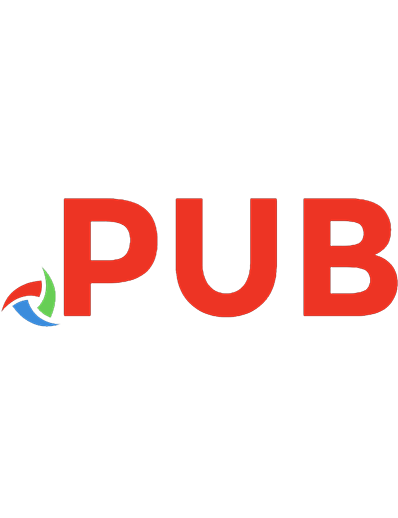

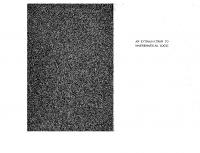
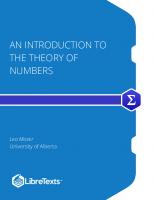
![Math4113/4213: Numbers, Sets and Functions 2018-2019 [version 21 Aug 2019 ed.]](https://dokumen.pub/img/200x200/math4113-4213-numbers-sets-and-functions-2018-2019-version-21-aug-2019nbsped.jpg)

